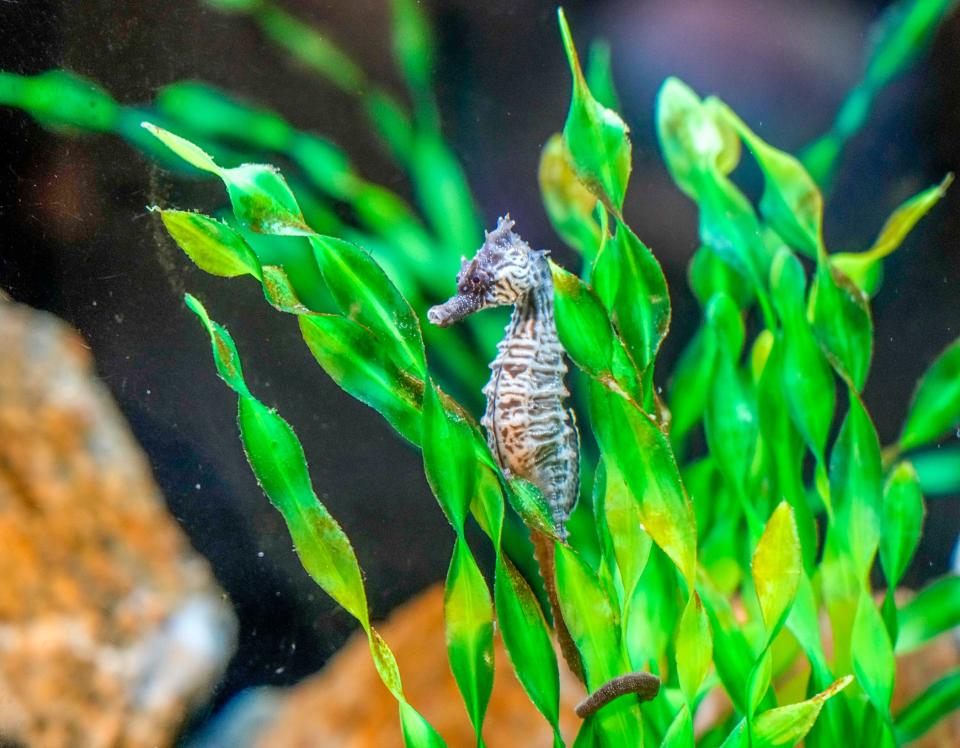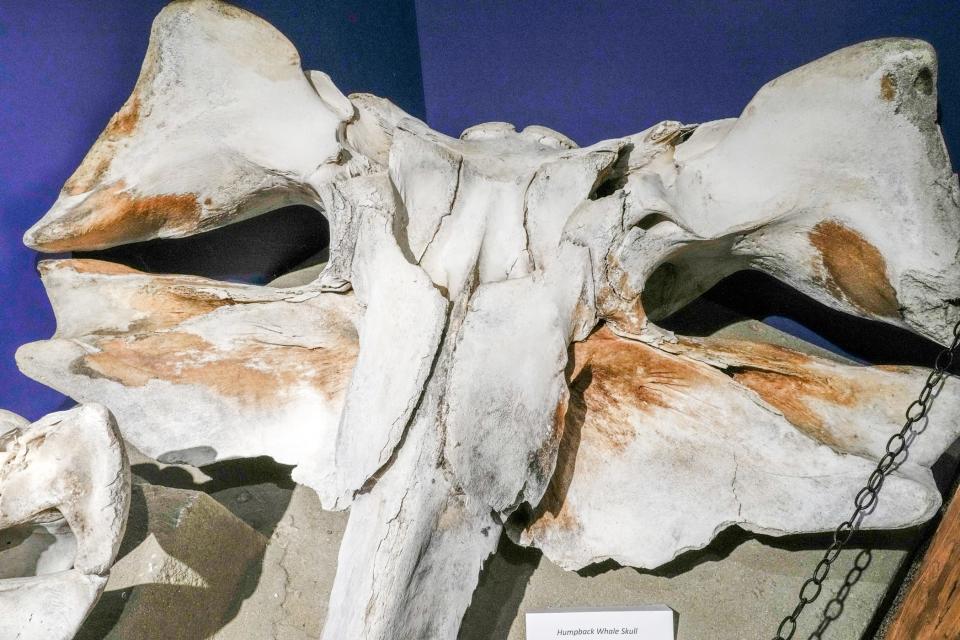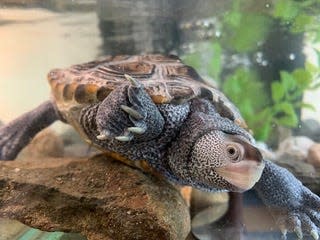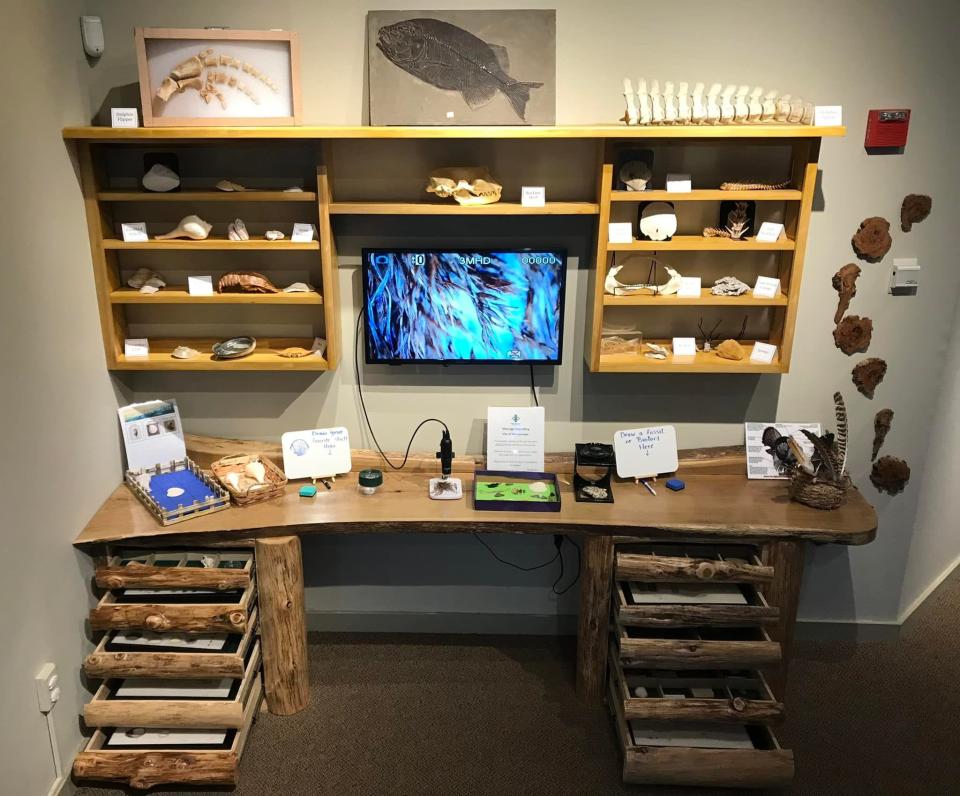Seahorses, giant whale skulls and more: Come see what's new at Audubon Nature Center
BRISTOL — Darwin is a little turtle with a big personality.
He lives at the Audubon Society of Rhode Island Nature Center & Aquarium, and when visitors pass his enclosure, he comes right up to the Plexiglas wall to peer at them inquisitively.
His enclosure includes a mirror, “because he likes to look at himself,” says Anne Dimonti, center director, and if she took him out, “he’d follow us around.”
“Everyone loves Darwin,” she says with a smile.
This summer, however, he shares star billing with new arrivals and exhibits, including a collection of lined seahorses, enormous skull bones from two species of whales, and in the Curiosity Corner, a new digital microscope.
What's a BioBlitz?: Amy Russo joins volunteers recording abundant life in ordinary places
Nature hike: Take in the fragile beauty of Warren's Touisset Marsh during a coastal hike
Those features join favorites like the 33-foot model of a juvenile North Atlantic right whale, and outside the center, the Palmieri Pollinator Garden — which includes a large insect habitat dubbed “Buggingham Palace" — as well as trails that lead to a boardwalk with a spectacular view of Narragansett Bay.
Seahorses put on a show at feeding time
The four new seahorses swim in an eye-level tank that makes them easy to observe. They are fed four times a day — a meal of shrimp so tiny they are dispensed via a pipette — which is a good time to watch how seahorses use their fins to swim through the water to grab a bite to eat.
Seahorses mate for life, says Dimonti, a marine biologist. Males can be identified by the pouch, visible on front, where females deposit eggs and leave the task of raising the young to the males.

Lined seahorses are native to the western Atlantic from Canada to Venezuela, but the quartet at the nature center were found off Tiverton last September by students from Roger Williams University.
“All the aquarium exhibits are maintained by students in marine biology at RWU,” Dimonti says. “It gives the students hands-on experience and [means] state-of-the-art care.”
RI Audubon Society's wildlife educator Lauren Parmelee is a force of nature
The whale skulls share the Rhode Island connection. The smaller bones, from a minke whale, washed up in Newport and have been Audubon property for several years, Dimonti says. More recently, the impressively larger humpback specimen was found on Block Island by researchers from the Atlantic Shark Institute.

It was up to the nature center staff to clean up the humpback bones for display.
“There was no flesh left, but they were a little smelly,” Dimonti notes. The problem was remedied in part by soaking the bones in a dilute solution of a common household cleaner, Simple Green, and leaving them in the sun.
Walking RI: Coastal views and prime bird-watching at Tiverton's Emilie Ruecker preserve
Walking RI: A birder's paradise by the shore in Middletown
As for Darwin, technically, he is a diamondback terrapin, named for the markings on his top shell. His neighbor in the new turtle tank exhibit is a female Eastern painted turtle named Tudley.
Both are found in Rhode Island, but their natural habitats identify them.
“Tudley is a true freshwater turtle and eats plant materials as well as small fish,” Dimonti says. Darwin’s natural home is brackish water; he skips the “veggies” in favor of fish and shrimp.

Permits from state or federal government, sometime both, are required for protected animals, such as the turtles, and also for the whale bones. Only approved organizations may apply for permits.
“You must show that the animals can’t be released into the wild, because they are so adapted to humans [like Darwin, who previously had been kept illegally as a pet] or they are injured,” Dimonti says. “You have to say how they will be treated and exhibited.”
Capital raptors: Photo book chronicles Providence's thriving birds of prey
Rhode Island Beaches 2022: Your guide to the best beaches in the state
As for the bones, “You can’t prove you didn’t kill the animal to get the bones,” she says. “That applies to birds’ feathers and eggs, too. It’s all about protecting the species.”
Manmade models, like the life-sized juvenile right whale, offer different informational pathways. Seen from one side, the model whale’s size is overwhelming, but on the other is a cross section that opens into the body cavity where a huge heart, lung, ribs and tongue are represented. Then imagine the proportions had this been a model of a 55-foot adult.
From giant to microscopic: What you can learn at the Curiosity Corner
For contrast, look at tiny details using a new digital microscope in the inviting Curiosity Corner. A rustic desk has drawers full of specimens to put under the scope, and the images are magnified on a large display screen. Visitors also are welcome to put their own finds from walking the nature trails under the microscope.
Those trails are not to be missed, especially the one that winds through a field, freshwater wetlands and a salt marsh, right to the edge of Narragansett Bay.

The same goes for the pollinator garden, a showcase for native plants maintained in collaboration with the University of Rhode Island’s Master Gardeners. Native plants thrive because they are on home turf, Dimonti notes. Native flora, moreover, support local fauna, including the bugs and bees that inhabit “Buggingham Palace,” an intricate structure of natural materials with lots of nooks and crannies where the creatures live year-round.
The link among all the exhibits at the nature center — including freshwater tanks, salty tidal pools and the beautiful grounds — is Rhode Island.
“Everything here is what’s in our own Rhode Island backyards,” Dimonti says.
If you go…
What: Audubon Society of Rhode Island Nature Center & Aquarium
Where: 1401 Hope St., Bristol
When: Open daily, 9:30 a.m.-4 p.m.; trails and grounds open sunrise to sunset
Admission: $6 adult, $5 senior, $4 child 4-12, free for children under 4 and for Audubon Society of RI members.
Info: asri.org, (401) 949-5454, ext. 3118
This article originally appeared on The Providence Journal: Bristol's Audubon Nature Center has new exhibits

